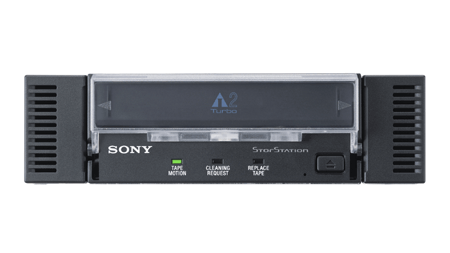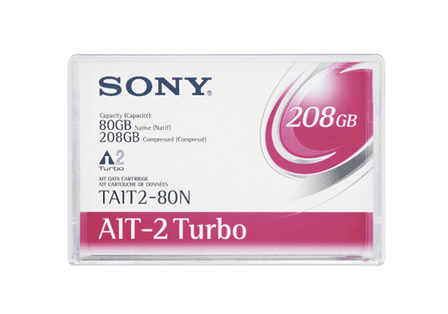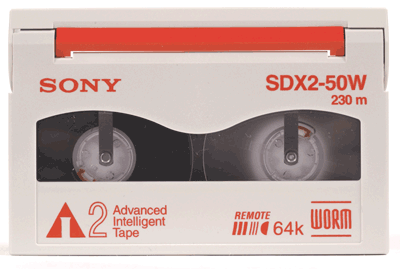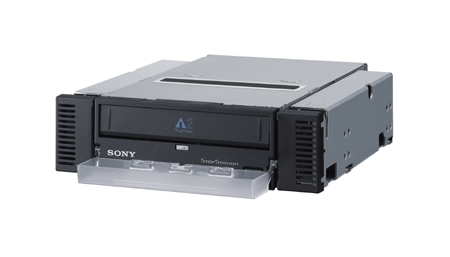Sony StorStation AITi200S – Data Backup Solution Review
Sony StorStation AITi200S – Data Backup Solution
If you're paranoid about losing all the data on your network, you need a fast, reliable and high capacity backup solution - Sony has just the thing.

Verdict
Key Specifications
- Review Price: £747.00
Small businesses looking to run a network data protection strategy will find that tape is still one of the best choices for backup. It offers an unbeatable combination of capacity, price and performance ideally suited to businesses looking to secure their servers and workstations to single device. These same businesses are also spoilt for choice as a wide range of manufacturers are vying for their attention with Sony very much at the head of the pack with its extensive range of AIT (advanced intelligent tape) products.

The latest StorStation AITi200, or AIT-2 Turbo, family targets small businesses looking for an affordable high-capacity, high-speed tape drive. At £747 for the internal model it certainly compares very well with the competition, but the AIT-2 Turbo also delivers an unbeatable capacity and performance. The compact cartridges have a native, or uncompressed, capacity of no less than 80GB while the drive delivers a speedy 12MB/sec native transfer rate. Sony’s ADLC (adaptive lossless data compression) technology is also more efficient and its top compression ratio of 2.6:1 allows maximum capacity to be stretched to 208GB. However, don’t be swayed by the latter feature as very little data can be compressed to this level.
Sony has made some modifications to the media to reduce storage costs even further. The standard 8mm cartridges offer a feature called MIC (memory in cartridge) which consists of a 64Kbit flash memory chip mounted internally and accessed via a five pin connector. The main function of MIC is to reduce the time spent searching for data as it stores information that is normally found on the first segments of the tape. MIC creates up to 64 partitions on the tape that can be accessed independently using address information stored in the chip and this allows the drive to estimate how far to fast-forward or rewind the tape. During loading, a small board springs up and makes contact with the five pins on the back of the cartridge allowing the drive to access the internal memory chip. This is an automatic function of the drive and there is no control of this feature extended to the backup software. In practice we’ve never seen MIC deliver any significant improvements over competing tape formats and you can now purchase lower cost media that doesn’t have the MIC chip. These tapes cost around £27 each as opposed to £33 for the MIC version.

”’The standard cartridges have the MIC chip removed to reduce storage costs.”’
However, Sony has a new use for MIC as it now implements support for WORM (write once read many). The AIT-2 Turbo drive can also read and write to Sony’s standard AIT-2 WORM cartridges allowing it to be used for secure data archiving. The MIC chip prevents cartridges being formatted or overwritten and stops existing data from being deleted. However, once a tape has been written to it will allow data to be added to unused portions of the tape. WORM support is now becoming highly desirable as data protection regulations governing archival storage get ever stricter. Many businesses are now under legal obligations to show that once critical company data has been archived it cannot be tampered with or changed.

”’The AIT-2 Turbo drive can also create, read and write to Sony’s new WORM cartridges.”’
To test performance we installed the drive on a dual 2.4GHz Xeon server with 2GB of PC2100 memory and running Windows Server 2003. The storage subsystem was a triplet of Ultra320 SCSI drives in a RAID-5 array and to avoid any data contention the Sony drive was connected to a dedicated Adaptec Ultra320 adapter card. Computer Associates BrightStor ARCserve for Windows r11 stood in for backup software duties and the drive was asked to backup, verify and restore 9.5GB of test data. This consisted of a mish-mash of documents, spreadsheets, databases and presentations along with HTML files, video clips, bitmaps, sound files and Acrobat .PDF files. The drive clearly has no difficulties reaching its quoted native speed as ARCserve reported an excellent 13.3MB/sec for the backup task. A full tape to disk verification also returned similar speeds while a full restoration of the backup data to its original location returned an equally impressive 12.7MB/sec.

For many years small business backup was dominated by the DDS format with it holding over 50 per cent of the market. However, its demise in 2001 and subsequent resurrection in 2003 hasn’t helped its cause at all with the latest DAT72 drive offering no performance improvements over its predecessor. Sony’s new AIT drive beats it on all counts as it is four times faster, has double the native capacity and yet costs almost the same. An equally important consideration is that the developers, Hewlett Packard and Certance have yet to announce a product roadmap so the DAT72 currently has no confirmed successor that companies can upgrade to. Sony, on the other hand, already has the AIT-3 and AIT-4 formats available and has always committed to producing two more generations after these.
”’Verdict”’
Sony delivers a top notch tape drive ideally suited to network backup for small businesses. It knocks DAT72 into a cocked hat for both performance and capacity and yet costs around the same price. It also has the benefit of a much safer migration path allowing businesses to upgrade easily as demand increases.

